Zircon
There are three types of Zircon; high type, intermediate type and low (metamict) type.
See below "Worth knowing"
Name: from the Persian azargun, gold coloured
Synonyms and trade names: Hyazinth (for orange and red Zircons), Starlite (blue), Azorite
Can be confused with: high and intermediate Zircons (see below "Interesting Facts") can hardly be mistaken due to the extremely high specific gravity and the very strong double refraction.
Green low (metamict) Zircons might be confused with other green stone such as green Tourmaline (Verdelite). Tourmalines, however are strongly doubly refractive and distinctly pleochroic, which easily separates them from the singly refractive metamict Zircons.
Demantoid Garnets can be distinguished by the high dispersion, horse-tail inclusions (in Russian Demantoids) and the higher refractive index of 1,875 (low type Zircon 1,78 to 1,81).
Green Grossular Garnets (Tsavorite) can be distinguished by their lower refractive index of 1,73 to 1,75.
Localities: Zircon is one of the most common minerals on earth. Some sources of commercial importance are Cambodia, Sri Lanka, Australia, Burma (Myanmar), Thailand and others.
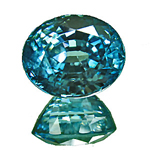
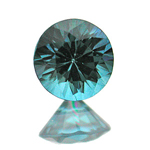
Blue Zircons from Cambodia
The blue colour is produced by heat-treating brown Zircons
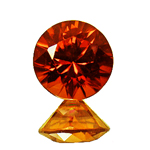
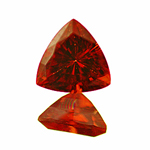
Orange Zircons (Hyazinth)
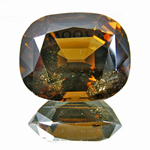
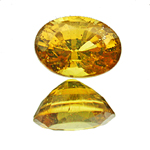
Brown and yellow Zircon from Sri Lanka
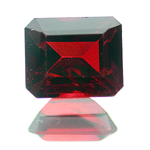
A beautiful red Zircon (Hyazinth), locality unknown, probably from India
Handling: Zircon is rather hard and cleavage is indistinct but it is rather brittle. Facet edges can be abraded or damaged rather easily, so Zircon jewellery should be worn with care.
Store individually in stone papers. Lots should be stored in gemstone boxes. Make sure that the stones cannot move in the box and damage each other.
Set and polish with care. Do not clean ultrasonically.
Zircons must be protected from heat. Remove from the setting before soldering. Colourless and brown stones in particular might change colour when heated.
Worth knowing: Zircons contain traces of the radioactive elements uranium, thorium and strontium. Radiation emanated from these elements is extremely low and utterly harmless. The reach of alpha particles in air is only 10cm and penetration into organic matter is only 40µm. This means that even if alpha particles reach the skin they cannot penetrate the outermost layer of dead cells.
If you hold a 50cts Zircon in your bare hand for one hour, the hand will be exposed to approximately 0,01 millirem of radiation. The maximum permissible dose is 50.000 millirem per year. So in order to reach that limit you must hold that 50cts Zircon for 5 million hours per year, which obviously is impossible.
In geological terms of time, however, the constant interior bombardment with alpha particles suffices to destroy the crystal structure. So in the course of time high type Zircons change to intermediate types (reddish, yellowish green or brownish green) and on to low (metamict) types which are mostly green, sometimes orange-green. Low type Zircons have completely (or almost completely) lost their crystal structure and are more or less amorphous. An orderly crystal structure being a pre-requisite of double refraction, low type Zircons are singly refractive.
Zircons are the oldest minerals known on earth (and on the moon), having formed up to 4,4 billion years ago.
Until a few decades ago, Zircons were universally known as lively natural gemstones. And because they register a fine 7.5 on Mohs´ scale of hardness, Zircons were commonly used in jewellery. Colourless Zircons were popular Diamond imitations (along with other colourless gemstones) and orange and red Zircons (termed "Hyazinth" in former times), as well as the blue varieties, produced by heat-treating colourless and brown stones (there is no naturally occurring blue Zircon), were highly sought after, not only by collectors.
Alas, things changed quickly with the appearance of stabilized zirconium oxide, mostly called CZ in the English-speaking world. This man-made stone was first synthesized in 1930. Mass production started in 1976 and by 1980 had already reached 50 million carats per year!
In German the trade name "Zirkonia" quickly took hold and the linguistic closeness to the real thing surely accelerated the cometlike rise of the new lab-created product.
The overwhelming commercial success of cubic zirconia had devastating effects on the reputation of Zircons, sending them from stardom to near oblivion in no time at all. In fact today Zircons are frequently and mistakenly thought to be man-made, a fate which these wonderful gems clearly do not deserve.
 Deutsch
Deutsch